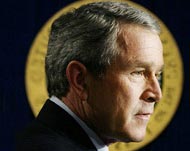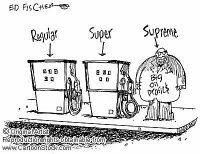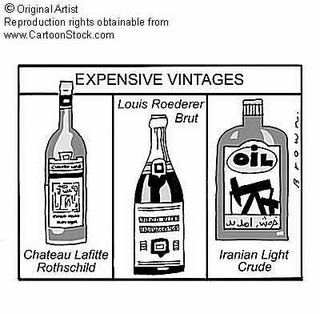Monday, June 05, 2006
The Gas Price Rollercoaster and a Creative Solution to the Oil Crisis

In April and early May gas prices rose sharply, and the country was up in arms about the change in the average citizen’s real salary and the gross profits achieved by the Big 5 oil companies. On May 5th, a barrel of oil peaked at $75, the end of a sharp climb in prices, and we really felt the pinch at the pump. Then, on Monday May 8th, the announcement came of a sharp drop in the price of a barrel of oil. Since then the price of oil has been slowly creeping up, nearing the May 5th peak.
You may remember in the days leading up to the May 5th peak, members of congress, and even the White House, were suggesting a number of policies to provide relief to consumers, including sending each driver a $100 check from Big 5 Oil’s profits, repealing the gas tax, and abolishing an increase in emission standards (which did occur). But with the decrease in oil prices, these issues were put aside, leaving prices to slowly rise again without causing such alarm.
Bush a Hero? Yeah, right!
 One particularly pro-Bush friend pointed to the dropping price as proof of George Bush’s cunning and strong leadership, but I saw through it, and told him that within three months the price for a barrel of oil would be over $70 again, but this time the oil companies’ profits wouldn’t be threatened.
One particularly pro-Bush friend pointed to the dropping price as proof of George Bush’s cunning and strong leadership, but I saw through it, and told him that within three months the price for a barrel of oil would be over $70 again, but this time the oil companies’ profits wouldn’t be threatened.
To prove my conviction, I told my friend I wouldn’t post my plan to radically alter the United States’ consumption of gasoline until prices reached that point. But I did, and do, have a plan, a plan that if implemented would have real effects on the price of gasoline, our economy, the environment, and our relations with countries in the Middle East. That plan is finally posted here.
When the markets opened in Singapore this morning, oil prices passed $73 a barrel, and I had won my bet (though I had hoped to lose it). Indeed, no one is calling for a tax on the billions of dollars in profits earned by Big 5 Oil in Q1 2006, and pumps on my street haven’t been under $3 in weeks. Big Oil gets richer, we get poorer, and this time people have grown to accept the changes. A serious feather in Bush’s cap, indeed.
Payback for Big Oil’s Getting Fat from our Paychecks
 First off, let me say I do believe that, for reasons stated in my first post on rising gas prices, I think that Big 5 Oil did make extraordinary profits from American citizenry in Q1 2006, and they probably did again in Q2, and some retribution is owed to the American public (though I feel the grievances were much less than most democrats, and even lesser than some republicans).
First off, let me say I do believe that, for reasons stated in my first post on rising gas prices, I think that Big 5 Oil did make extraordinary profits from American citizenry in Q1 2006, and they probably did again in Q2, and some retribution is owed to the American public (though I feel the grievances were much less than most democrats, and even lesser than some republicans).
Let’s take a look at the White House’s proposal to give $100 to each driver in this country. There are 209+ million people over the age of 18 living in the United States today. Let’s say that 75%, or approximately 150 million have a drivers license. If the government decided to send each of these people $100 from Big Oil that would cost Big Oil $15 Billion, almost all of Big Oil’s combined $16 Billion in profits from Q1 2006.
Now if George Bush was earnest in his proposal, then there should be $15 Billion available for any program that could provide real relief from this crisis, right? However, as I said before, I think Big Oil’s culpability is lesser than most people, because the market was out of balance before this year, so I want only 20% of that money, or $3 Billion. Frankly, the oil companies are getting off pretty easy on the Nomadic plan.
The Nomadic Plan – a Real Solution
 The Nomadic Plan (i.e. my plan) is a program designed to move 10 Million drivers to hybrid cars, or 20 Million drivers to diesel cars, over a short period of time. This would seriously reduce the amount of gasoline consumed by the American people, especially if the program could target owners of less efficient automobiles. The program would also serve to spur the economy, especially if incentives were included to buy American.
The Nomadic Plan (i.e. my plan) is a program designed to move 10 Million drivers to hybrid cars, or 20 Million drivers to diesel cars, over a short period of time. This would seriously reduce the amount of gasoline consumed by the American people, especially if the program could target owners of less efficient automobiles. The program would also serve to spur the economy, especially if incentives were included to buy American.
So how would the government accomplish this? In the Nomadic plan, the government would offer a series of incentives for trading in an automobile for the more fuel-efficient car. The first incentive would be $1,000 cash to any citizen or small business choosing to trade their car for a hybrid, or $500 to trade into a diesel. These incentives can be increased if trading in a truck or older gas guzzler.
The second incentive would be $1,000 to the dealership towards the trade-in value of the car they will receive. This means that even the oldest, worst car would have a trade-in value of $1,000. The final incentive would be $1,000 towards the finance companies to provide 0% financing with no down payment for people or companies taking advantage of the deal.
Would You Do It?
 Would you trade your car in for a hybrid if you didn’t have to pay any money up front, got $1,000 cash back, and your trade-in was worth $1,000 more? Yes, you have payments to make on a new car, but with the increased price of gas, your payments will be largely offset by your savings at the pump. And the more gas your old car consumed, the more your payments will be offset by the program.
Would you trade your car in for a hybrid if you didn’t have to pay any money up front, got $1,000 cash back, and your trade-in was worth $1,000 more? Yes, you have payments to make on a new car, but with the increased price of gas, your payments will be largely offset by your savings at the pump. And the more gas your old car consumed, the more your payments will be offset by the program.
Consumer Markets
Small businesses, presently struggling under the weight of increased gas prices, would see serious advantages to making this move. Whole fleets of trucks could be traded in on diesels, with old trucks having no previous value suddenly having a trade-in value and each new truck representing an influx of cash which can be used to improve the business.
Similar effects would be seen amongst people with older cars. These cars have minimal trade in value, so the trade-in incentive will represent a drastic increase in worth for the older cars. And since these cars tend to be very inefficient, drivers would see their payments offset almost completely by savings in gas. Meanwhile, the country benefits from removing these less efficient cars from the road.
Economic Effects
 The United States consumes 20 million barrels of oil each day, or 400 Million gallons of gas a year. As such, even a 5% decrease in the gasoline consumed in this country represents a whopping million barrels of oil that the US wouldn’t need if this program were successful. The decrease in demand would also convert to a decrease in price, as we witnessed in my second post on gas prices in May.
The United States consumes 20 million barrels of oil each day, or 400 Million gallons of gas a year. As such, even a 5% decrease in the gasoline consumed in this country represents a whopping million barrels of oil that the US wouldn’t need if this program were successful. The decrease in demand would also convert to a decrease in price, as we witnessed in my second post on gas prices in May.
If the program were successful, the decrease in gas prices would translate into a relative increase in purchasing power from the average paycheck. History shows us this money will circulate back into the economy as consumers make more purchases, and the economy will thrive. Additionally, the increase in small businesses illustrated earlier will mean more jobs, also invigorating the economy.
The struggling auto manufacturers in this country will benefit greatly from moving into the hybrid arena to meet increasing demand. Incentives to trade into American cars will further push American auto makers to create a line of cars that match our country’s growing need for fuel efficient automobiles.
Finally, if this program were implemented and were successful, it would probably be continued, as it will take some time to actually bring Big 5 Oil’s profits down to a consistently reasonable level. Implementing the Nomadic Plan once a year would see increased benefits as the country sees real improvements in its reliance on oil.
Conclusion
The Nomadic Plan offers a real program that could reduce our dependence on oil, and on the countries of the Middle East that we presently see as, predominantly, adversaries. It calls for Big 5 Oil to relinquish as percentage of their inflated profits, and for these funds to be utilized to convert consumers to gas-efficient automobiles.
The plan represents but one creative response to our present gas price crisis, leading to the question of why no creative plans have been offered up by our country’s leadership. Each day that we do nothing about the present situation, citizens and small businesses are effected by higher gas prices, our political standing with the Middle East grows worse, and the effects on the environment appear devastating.
The time has come for action of some sort, for a plan that starts to decrease our reliance on oil. This is one plan. Let’s hope that our government finds a plan and implements it sooner than later.
technorati tags: Oil, Gas, Price, Solution, Congress, White House, George Bush, Nomadic Plan, Small Business, Hybrid, Diesel
Roller Coaster by Susan Marczak
Posted by Scottage at 4:28 AM /
| |




 One particularly pro-Bush friend pointed to the dropping price as proof of George Bush’s cunning and strong leadership, but I saw through it, and told him that within three months the price for a barrel of oil would be over $70 again, but this time the oil companies’ profits wouldn’t be threatened.
One particularly pro-Bush friend pointed to the dropping price as proof of George Bush’s cunning and strong leadership, but I saw through it, and told him that within three months the price for a barrel of oil would be over $70 again, but this time the oil companies’ profits wouldn’t be threatened.  First off, let me say I do believe that, for reasons stated in my first post on rising gas prices, I think that Big 5 Oil did make extraordinary profits from American citizenry in Q1 2006, and they probably did again in Q2, and some retribution is owed to the American public (though I feel the grievances were much less than most democrats, and even lesser than some republicans).
First off, let me say I do believe that, for reasons stated in my first post on rising gas prices, I think that Big 5 Oil did make extraordinary profits from American citizenry in Q1 2006, and they probably did again in Q2, and some retribution is owed to the American public (though I feel the grievances were much less than most democrats, and even lesser than some republicans). The Nomadic Plan (i.e. my plan) is a program designed to move 10 Million drivers to hybrid cars, or 20 Million drivers to diesel cars, over a short period of time. This would seriously reduce the amount of gasoline consumed by the American people, especially if the program could target owners of less efficient automobiles. The program would also serve to spur the economy, especially if incentives were included to buy American.
The Nomadic Plan (i.e. my plan) is a program designed to move 10 Million drivers to hybrid cars, or 20 Million drivers to diesel cars, over a short period of time. This would seriously reduce the amount of gasoline consumed by the American people, especially if the program could target owners of less efficient automobiles. The program would also serve to spur the economy, especially if incentives were included to buy American. Would you trade your car in for a hybrid if you didn’t have to pay any money up front, got $1,000 cash back, and your trade-in was worth $1,000 more? Yes, you have payments to make on a new car, but with the increased price of gas, your payments will be largely offset by your savings at the pump. And the more gas your old car consumed, the more your payments will be offset by the program.
Would you trade your car in for a hybrid if you didn’t have to pay any money up front, got $1,000 cash back, and your trade-in was worth $1,000 more? Yes, you have payments to make on a new car, but with the increased price of gas, your payments will be largely offset by your savings at the pump. And the more gas your old car consumed, the more your payments will be offset by the program.  The United States consumes 20 million barrels of oil each day, or 400 Million gallons of gas a year. As such, even a 5% decrease in the gasoline consumed in this country represents a whopping million barrels of oil that the US wouldn’t need if this program were successful. The decrease in demand would also convert to a decrease in price, as we witnessed in my second post on gas prices in May.
The United States consumes 20 million barrels of oil each day, or 400 Million gallons of gas a year. As such, even a 5% decrease in the gasoline consumed in this country represents a whopping million barrels of oil that the US wouldn’t need if this program were successful. The decrease in demand would also convert to a decrease in price, as we witnessed in my second post on gas prices in May.